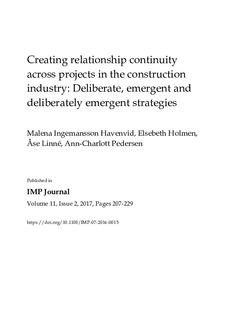| dc.description.abstract | Purpose
The purpose of this paper is to investigate the relationship continuity across projects among actors in the construction industry, and to discuss why and how such continuity takes place.
Design/methodology/approach
The authors draw on the results from four in-depth case studies illustrating different strategies for pursuing relationship continuity. The results are analysed and discussed in light of the oft-mentioned strategies suggested by Mintzberg (1987): emergent, deliberate and deliberately emergent strategies. Furthermore, the ARA-model is used to discuss why the relationship continuity strategies are pursued, and which factors might enable and constrain the relationship continuity.
Findings
The main findings are twofold. First, the authors found that the strategy applied for pursuing relationship continuity may, in one-time period, contain one type of strategy or a mix of strategy types. Second, the type of strategy may evolve over time, from one type of strategy being more pronounced in one period, to other strategies being more pronounced in later periods. The strategies applied by construction firms and their counterparts can thus contain elements of emergent, deliberate and deliberately emergent strategies, in varying degrees over time. It is also shown that the strategies of the involved actors co-evolve as a result of interaction. Also, the main reasons for pursuing continuity appear to lie in the re-use and development of important resources and activities across projects to create efficiency and the possibility to develop mutual orientation, commitment and trust over time, and thus reduce uncertainty.
Research limitations/implications
Further empirical studies are needed to support the findings. For managers, the main implication is that relationship continuity can arise as part of an emerging interaction pattern between firms or as part of a planned strategy, but that elements of both might be needed to sustain it.
Originality/value
The authors combine Mintzberg’s strategy concepts with the ARA-model to bring new light to the widely debated issue of discontinuity and fragmentation in the construction industry. | nb_NO |
